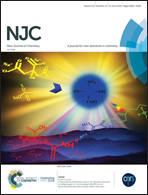Low-temperature catalytic oxidation of aniline to azoxybenzene over an Ag/Fe2O3 nanoparticle catalyst using H2O2 as an oxidant†
Abstract
An in situ modified hydrothermal synthesis of Ag/Fe2O3 nanoparticles (NPs) and studies of their catalytic activity as a simple, eco-friendly and recyclable catalyst for one-pot conversion of aniline to azoxybenzene were performed. The as-synthesized nanostructured material was characterised by powder X-ray diffraction (XRD), transmission electron microscopy (TEM), scanning electron microscopy (SEM), SEM-mapping, temperature-programmed reduction (H2-TPR), X-ray photoelectron spectroscopy (XPS), N2 adsorption–desorption isotherms (BET), Fourier transform infrared spectroscopy (FT-IR), inductively coupled plasma–atomic emission spectroscopy (ICP-AES), ultraviolet-visible spectroscopy (UV-vis) and vibrating sample magnetometer spectroscopy (VSM). The most active and recyclable catalyst with 2–5 nm diameters of the metallic Ag particles supported on 10–50 nm Fe2O3 nanoparticles was formed with a silver loading of 1.8 wt%. A high turnover number of ∼592 was achieved with 92% conversion of aniline and 94% selectivity towards the target product azoxybenzene under atmospheric conditions. The effects of various reaction parameters including the reaction time, temperature and substrate to H2O2 molar ratio were screened and studied in detail. The results reveal the role of a synergistic effect between the surface Ag nanoparticles and Fe2O3 nanospheres for high catalytic activity.



 Please wait while we load your content...
Please wait while we load your content...